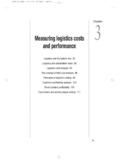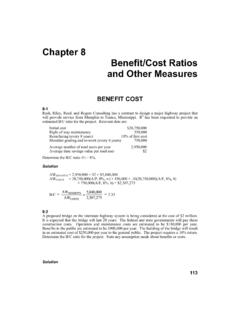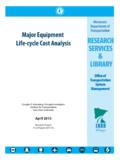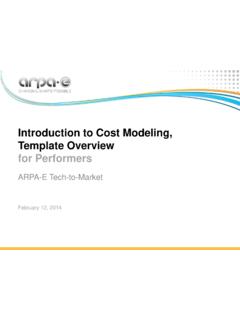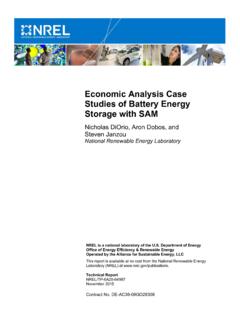Transcription of Chapters 11&12 -- Capital Budgeting
1 60 Chapters 11&12 -- Capital Budgeting Capital Budgeting Project classifications Capital Budgeting techniques Cash flow estimation Risk analysis in Capital Budgeting Optimal Capital budget Capital Budgeting Strategic business plan: a long-run plan that outlines in broad terms the firm s basic strategy for the next 5 to 10 years Capital Budgeting : the process of planning expenditures on assets with cash flows that are expected to extend beyond one year Project classifications Replacements: Need to continue current operations Need to reduce costs Expansions: Need to expand existing products or markets Need to expend into new products or markets Others: safety/environmental projects, mergers Capital Budgeting techniques (Chapter 11) (1) Net present value (NPV): present value of future net cash flows, discounted at the cost of Capital NtttrCFNPV0)1(, where r is the cost of Capital , CFt is the cash flow in time t (2) Internal rate of return (IRR): rate of return a project earns (a discount rate that forces a project s NPV to equal zero) NtttIRRCFNPV00)1( Problems associated with IRR.
2 Multiple rates of return and unrealistic reinvestment rate assumption 61 (3) Modified internal rate of return (MIRR): discount rate at which the present value of initial cost is equal to the present value of the terminal value (4) payback period: the length of time (years) required for an investment s cash flows to cover its cost (5) Discounted payback period: the length of time (years) required for an investment s cash flows, discounted at the investment s cost of Capital to recover its cost Examples: basic data for projects L and S (1) NPV approach TI BAII plus or TI BAII plus professional (CF function) Press CF first, then press 2nd, followed by pressing CLR WORK CF0 = -1,000, enter, ; C01 = 500, enter, , F01 = 1, ; repeat the same procedure to enter C02 = 400, C03 = 300, and C04 = 100; press NPV, you see I = ; enter 10, press enter and , you will see NPV = ; press CPT (on the up left corner); NPV = (keep 4 decimals) Exercise: check NPVL = Decision rule: if NPV > 0, accept the project; if NPV < 0, reject the project 62 Independent vs.
3 Mutually exclusive projects Independent projects are projects with cash flows that are not affected by the acceptance or rejection of other projects Mutually exclusive projects are a set of projects where only one can be accepted What if L and S are mutually exclusive? Choose L because NPVL > NPVS In general, you should choose the project with the highest positive NPV If they are independent, you should choose both because NPV for both > 0 (2) IRR approach TI BAII plus or TI BAII plus professional (CF function) Press CF first, then press 2nd, followed by pressing CLR WORK CF0 = -1,000, enter, ; C01 = 500, enter, , F01 = 1, ; repeat the same procedure to enter C02 = 400, C03 = 300, and C04 = 100; press IRR, you will see IRR = ; press CPT (on the up left corner); IRR= (keep 4 decimals) Exercise: check IRRL = Decision rule: if IRR > r, accept the project.
4 If IRR < r, reject the project where r is the hurdle rate (the required rate of return for the project) Multiple IRRs: the situation where a project has two or more solutions (or IRRs) Reinvestment rate assumptions: NPV approach is based on the assumption that cash flows can be reinvested at the project s risk-adjusted WACC, where the IRR approach is based on the assumption that cash flows can be reinvested at the project s IRR 63 (3) MIRR approach (1) Compound each future cash inflow to the terminal year , using WACC (2) Add all the future values to get terminal value (3) Calculate I/YR to get MIRR Decision rule: if MIRR > r, accept the project; if MIRR < r, reject the project where r is the hurdle rate (the required rate of return for the project) 64 NPV profile: a graph that shows the relationship between a project s NPV and the firm s cost of Capital When r < , NPV for S is positive, which means that the project will be accepted When r > , NPV for S is negative, which means that the project will be rejected 65 NPV profiles for project L and S Crossover rate: the cost of Capital at which the NPV profiles of two projects cross and thus, at which the projects NPVs are equal How can you calculate the crossover rate ( )?
5 If the cost of Capital is less than , L is a better project. If the cost of Capital is greater than (but less than ), S is a better project. 66 Ranking problem (conflict): NPV approach and IRR approach sometimes will lead to different rankings for mutually exclusive projects For example, using NPV approach, project L is better than project S if the cost of Capital is 10% (L has a higher NPV than S). Other the other hand, using IRR approach, S is better than L (S has a higher IRR than L) If ranking problem occurs use NPV approach to make the final decision Main conditions to cause conflicts a. Timing of cash flows b. Scale of cash flows (4) payback period approach unrecovered cost payback = # of years prior to full recovery + ---------------------------------------- - cash flow in full recovery year Decision rule: If payback < maximum payback , then accept the project If payback > maximum payback , then reject the project Weaknesses: Arbitrary maximum payback Ignores time value of money Ignores cash flows after maximum payback period 67 (5) Discounted payback period approach Step 1: discount future cash flows to the present at the cost of Capital (round to the nearest whole dollar) Step 2.
6 Follow the steps similar to payback period approach Decision rule: similar to that of payback period Weaknesses: Arbitrary maximum discounted payback period Ignores cash flows after maximum discounted payback period Decision criteria used in practice 68 Cash flow estimation (Chapter 12) Guidelines when estimating cash flows: Use after tax cash flows Use increment cash flows Changes in net working Capital should be considered Sunk costs should not be included Opportunity costs should be considered Externalities should be considered Ignore interest payments (separate financing decisions from investment decisions) FCF = [EBIT*(1 - T) + depreciation] [ Capital expenditures + NOWK) EBIT*(1 - T) = net operating profit after tax = NOPAT NOWK = change in net operating working Capital Steps in estimating cash flows: (1) Initial outlay (2) Differential (operating) cash flows over project s life (3) Terminal cash flows (4) Time line and solve Example.]
7 An expansion project Allied is considering purchasing an equipment. The cost is $900,000 (t = 0). The inventory will increase by $175,000 and account payable will increase by $75,000 (the net change in operating working Capital will be $100,000). The project will last for 4 years. Allied forecasts of sales of 537,000 units in year 1 (t =1), 520,000 units in year 2 (t = 2), 505,000 units in year 3 (t = 3), and 490,000 in year 4 (t = 4). The unit price is $10. The fixed cost is $2,000,000 each year and the variable cost to product each unit is $ for year 1 (t =1), $ for year 2 (t =2), $ for year 3 (t = 3), and $ for year 4 (t = 4). Allied will use MACRS and straight line depreciation methods to compare the results After 4 years, Allied expects a salvage value of the equipment to be $50,000.
8 The company expects to fully recover the NOWC of $100,000 The tax rate for the firm is 40% The project s WACC is estimated to be 10% Question: Should Allied take the project? 69 Since NPV is positive, Allied should take the project. Allied should use MACRS to depreciate the new equipment since NPV for the project will be higher. 70 Cash flow estimation: a new project The president of Real Time, Inc. has asked you to evaluate the proposed acquisition of a new computer. The computer s price is $40,000 and there will be another $2,000 for shipping and installation. The computer falls into MACRS 3- year class (Use 33%, 45%, 15%, 7% depreciation schedule).
9 Purchase of the computer would require an increase in net working Capital of $2,000. The computer would increase the firm s before-tax revenues by $20,000 per year but would also increase operating costs by $5,000 per year. The computer is expected to be used for 3 years and then be sold for $15,000. The firm s marginal tax rate is 40%, and the project s cost of Capital is 14%. a) What is the net initial outlay (at time t = 0)? b) What are the operating cash flows over 3 years? c) What is the terminal value (not including the operating cash flow in year 3)? d) Should the firm purchase the new computer? Answer: a) CF0 = 40,000 + 2,000 + 2,000 = $44,000 b) CF1 = (20,000 - 5,000) * (1 - ) + 42,000 * * = $14,544 CF2 = $16,560 CF3 = $11,520 c) TCF3 =15,000 - (15,000 - 42,000* )* + 2,000 = $12,176 Total cash flow in year 3 = 11520 + 12,176 = $23,696 d) NPV = - $2, < 0, IRR = < 14% Since NPV < 0, do not take the project.
10 Example: a replacement project Data for both old and new machines Sale revenue: $2,500 Expected life of the old and new machines: 4 years WACC: 10% Tax: 40% Data for old machine Salvage value today: $400 Old labor, materials, and other costs per year: $1,000 Old machine depreciation: $100 (straight-line method) Data for new machine cost of new machine: $2,000 (MACRS depreciation, 33%, 45%, 15% and 7%) New labor, materials, and other costs per year: $400 Question: Should the firm buy the new machine to replace the old machine? 71 Since NPV for the project is positive, the firm should take the replacement project. Risk analysis in Capital Budgeting Adjusting the cost of Capital for risk Project stand-alone risk: the risk of a project as if it wer










